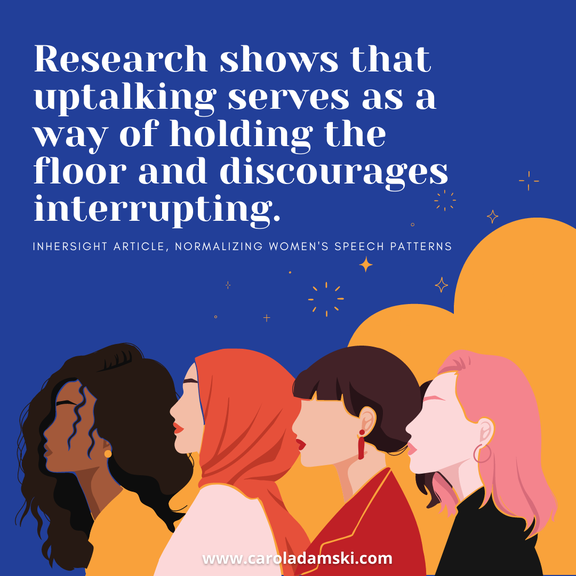If this term is new to you, it basically refers to the tone and pattern of female speech. For years, women have been counseled to shift and alter their normal way of speaking to be "better heard and taken seriously" by speaking with more masculine speech patterns. But this article challenges this advice, saying that women shouldn't have to shape shift to better fit within a patriarchal environment.
Uptalk & the Important of Normalizing Women's Speech Patterns
Uptalk, also called upspeak, is a linguistic term usually associated with how women speak. Many professionals advise women to eliminate the style of speaking entirely in order to be taken seriously in and out of the workplace, but this ill-advised guidance stems from patriarchal, sexist beliefs.
Here, we’ll walk through what uptalk is, how it's often perceived in the workplace, research on its benefits (yes, really), and the importance of normalizing women's speech patterns.
What is uptalk?
Dr. Kami Anderson, an interculturalist and linguist, says, “Uptalk is a lilt that is commonly used to soften communication. It’s a way that people use paralanguage, or the sound of their voice and intonations, to appear more friendly, personable, and approachable.”
Basically, it’s when sentences have a rising intonation at the end that causes statements to sound like questions. And although it’s used by both men and women, women seem to draw the short straw when it comes to criticism of the speaking style. Uptalk can even become a protection mechanism for women in order to avoid coming across as overbearing or bossy—sexist adjectives commonly used to undermine women leaders.
Another related linguistic style is called a vocal fry, a style in which a voice is dropped to its lowest natural register, which produces a creaking sound. And due to sexist ideas of what professionalism means, women are deemed unprofessional when their voice doesn’t fit into what is expected of them in male-dominated spaces.
Research shows that uptalk is generally perceived in a negative way. One study showed that young adult women voices containing a vocal fry are perceived as less competent, less educated, less trustworthy, less attractive, and less hirable.
Anderson says that the misconception about uptalk is that it’s a demonstration of a lack of confidence, when really, it’s subconsciously intended to not offend the receiver of the speech and welcomes feedback. She says, “We begin to perceive the ways in which we show empathy or compassion with our voices as a weakness, when in actuality it is a demonstration of our ability to consider the perception of others in the workplace. Socialization has indeed made the practice of uptalk more noticeable in women because it is perceived as a gendered communication trait, but...that perception is an extension of the patriarchal practices we find consistently in the workplace.”
That’s right, the harsh judgement and overt tone policing that accompany uptalk are all due to patriarchal expectations that still exist in society. Anderson says, “Patriarchal practices infer that the ‘male way’ is to be forceful, unapologetic, and commanding in all communicative situations and any deviation from that is inherently ‘feminine’ and can hinder success. This is a fatalistic trope in the workplace.”
But, are there benefits?
Let’s pause for a moment. Is there any positive research that shows uptalk as beneficial?
Yes, actually. Despite being regarded as an annoying, unconfident style of speaking, uptalk is actually a valuable communication tool. One study in Hong Kong found that meeting chairs—the most powerful people in the room—used rising intonation three to seven times more often than their subordinates did, suggesting that uptalk is useful in asserting leadership qualities.
Uptalk allows a speaker to keep their conversation partners engaged and attentive, which automatically demands respect. It’s an easy way to allow leaders to offer ideas to a group in a collaborative manner, rather than imposing demands, and establishes an environment of equality where leaders are also listeners. Other research shows that uptalking serves as a way of holding the floor and discourages interrupting.
Normalizing women’s speech patterns
Women are constantly policed for the tone and delivery of their speech. It’s a catch-22 where we’re told that we apologize too much, say “like” too much, and sound too submissive, yet we’re simultaneously told to not be too assertive or commanding. Not only is it unfair to judge someone solely based on their voice or tone, research shows that altering your speech at work can impair your ability to solve complex problems, generate ideas, and maintain personal investment in your work.
In and out of the workplace, we have to acknowledge that there are linguistic differences in the way that all people speak and that there isn't just one correct way to speak. It’s important to remain open-minded and receptive to linguistic trends and start examining our own language biases and prejudices. Women don’t need to “talk like men” in order to be respected.
Anderson says, “Normalizing [women’s] presence, which has been in the workplace for decades now, includes normalizing the ways we speak that are unique. True inclusivity requires acceptance of the whole person—our bodies, our work styles, and our speech patterns.”
Click here to read the article in its entirety and to learn more about Kami Anderson.

 RSS Feed
RSS Feed